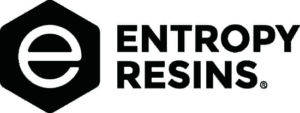The second phase of an LCA is to collect and model life cycle inventory (LCI) data. LCI data contains the details of the resources flowing into a process and the emissions flowing from a process to air, soil, and water.
The study uses a combination of primary and secondary data. Where primary data was not available (e.g. raw material extraction, processing of material inputs, transportation, disposal of scrap), ecoinvent v3.5, Cut-off at Classification (Weidma, 2013), which contains detailed peer-reviewed LCI data, was used. Primary data are used for the following:
• Energy, water, and material inputs and emission and waste outputs for manufacturing the LER product
• Transportation distances and modes for raw material transportation links
Under the direction of LTS, Entropy Resins gathered primary data on the bio-based product formulation and transportation distances and modes for raw materials, manufacturing inputs and outputs (e.g. energy consumption, water use, direct air emissions, waste), packaging and production volumes for the six month period between November 2018 and April 2019. It is assumed that the industry average petrochemical-based LER product is identical to the bio-based LER product, except for the epichlorohydrin, discussed in more detail below.
The following sections describe each of the key components and materials. Full details were provided to the critical reviewer separately.
Product Formulations
Entropy Resins have a proprietary formulation in which the base products, are reviewed against industry averages and environmental impacts are considered.
To manufacture the LER product, electricity and natural gas are consumed. In addition, water is consumed and discharged, VOC is directly emitted into the air, and waste is produced. Primary data from the bio-based formulation is used for these inputs and outputs for both the bio-based and industry average petrochemical-based LER products.
Data Quality and Geographic Boundaries
In practice, all data used in an LCA study is a mixture of measured, estimated, and calculated data. The quality of data is rarely homogenous. The sections below describe the data quality in this study. Gougeon Brothers manufacture LER products, in its facility in Bay City, Michigan, USA, and sources its materials globally.
Results of Life Cycle Assessment
The following sections summarize the key characterized results of the LCA including comparative contribution analyses of the bio-based and industry average petrochemical-based LER products. The life cycle inventory was analyzed using the LTS Method.
The image and table below show that 68% – 83% of the bio-based LER product impacts are from the epoxy backbone. Benzyl alcohol contributes 6% – 12% of overall impacts across all impact categories, while C12-C14 Alkyl Glycidyl Ether contributes 2% – 7%. Electricity contributes 3% – 12%, while natural gas contributes less than 3% across all impact categories. Packaging (55-gallon steel drum) contributes 4% – 8% depending on the impact category, while miscellaneous ingredients, water, wastewater, and manufacturing waste contribute less than 1%.

Industry average petrochemical-based LER product
As shown in the image and table below, 72% – 84% of the industry average petrochemical-based LER product impacts are from the epoxy backbone. Benzyl alcohol contributes 5% – 10% of overall impacts across all impact categories, while C12-C14 Alkyl Glycidyl Ether contributes 2% – 7%. Electricity contributes 2% – 10%, while natural gas contributes less than 3% across all impact categories. Packaging (55-gallon steel drum) contributes around 5% depending on the impact category, while miscellaneous ingredients, water, wastewater, and manufacturing waste contribute less than 1%.

Comparison of Bio-Based vs. Industry Average Petrochemical-Based LER Products
The bio-based LER product has between 11% – 16% fewer environmental impacts than the industry average petrochemical-based LER product, as shown in the table and image below. These differences are coming from the epoxy backbone. The bio-based LER product uses a bio-based ECH material, while the industry average petrochemical LER product uses a petroleum-based based ECH material.


Epoxy Backbone
As shown in the image and table below, 77% – 90% of the bio-based epoxy backbone impacts are from the BPA, while ECH contributes less than 1%. Miscellaneous ingredients contribute between 2% – 12%. Electricity contributes 5% – 9%, while natural gas contributes between 1% – 3% across all impact categories. Water, direct emissions, and wastewater contribute less than 3%.


Industry Average Petrochemical-Based Epoxy Backbone
As shown in the image and table below, 62% – 77% of the industry average petrochemical-based epoxy backbone impacts are from the BPA and ECH contributes 15% – 21%. Miscellaneous ingredients contribute between 2% – 10%. Electricity contributes 4% – 7%, while natural gas contributes between 1% – 3% across all impact categories. Water, direct emissions, and wastewater contribute less than 3%.

Comparison of Bio-Based vs. Industry Average Petrochemical-Based Epoxy Backbone
The bio-based epoxy backbone has between 15% – 20% fewer environmental impacts than the industry average petrochemical-based epoxy backbone, as shown in the table and image below. These differences are coming from the epichlorohydrin material. The bio-based LER epoxy backbone uses a bio-based epichlorohydrin material, while the industry average petrochemical LER epoxy backbone uses a petroleum-based epichlorohydrin material.


Next > Life Cycle Assessment Interpretations
View full LCA report from Long Trail Sustainability > Life Cycle Assessment Report
*Long Tail Sustainability is a third-party product stewardship practitioner used to create LCA models for our products that are based on international standards.
